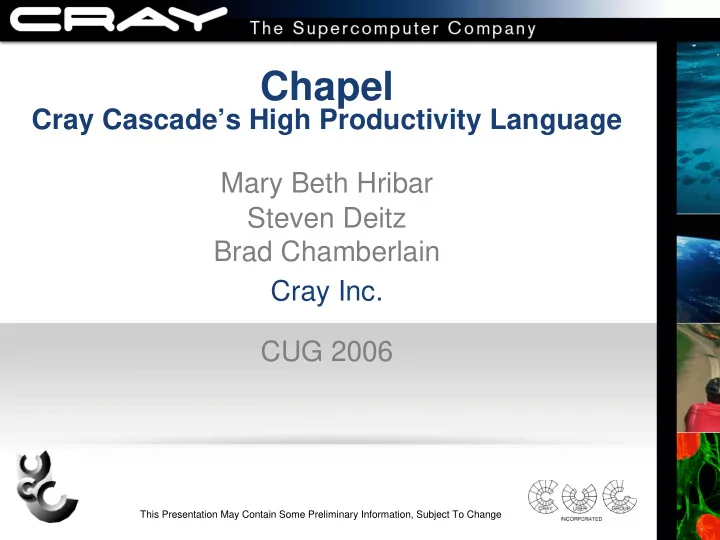

Chapel Cray Cascade’s High Productivity Language Mary Beth Hribar Steven Deitz Brad Chamberlain Cray Inc. CUG 2006 This Presentation May Contain Some Preliminary Information, Subject To Change
Chapel Contributors • Cray Inc. • Brad Chamberlain • Steven Deitz • Shannon Hoffswell • John Plevyak • Wayne Wong • David Callahan • Mackale Joyner • Caltech/JPL: • Hans Zima • Roxana Diaconescu • Mark James This Presentation May Contain Some Preliminary Information, Subject To Change
Chapel’s Context HPCS = High Productivity Computing Systems (a DARPA program) Overall Goal: Increase productivity by 10 × by 2010 Productivity = Programmability + Performance + Portability + Robustness Result must be… …revolutionary, not evolutionary …marketable product Phase II Competitors (7/03-7/06) : Cray (Cascade), IBM, Sun This Presentation May Contain Some Preliminary Information, Subject To Change
Chapel Design Objectives • a global view of computation • support for general parallelism • data- and task-parallel; nested parallelism • clean separation of algorithm and implementation • broad-market language features • OOP, GC, latent types, overloading, generic functions/types, … • data abstractions • sparse arrays, hash tables, sets, graphs, … • good performance • portability • interoperability with existing codes This Presentation May Contain Some Preliminary Information, Subject To Change
Outline � Chapel Motivation & Foundations � Context and objectives for Chapel � Programming models and productivity • Chapel Overview • Chapel Activities and Plans This Presentation May Contain Some Preliminary Information, Subject To Change
Parallel Programming Models • Fragmented Programming Models: • Programmers must program on a task-by-task basis: • break distributed data structures into per-task chunks: • break work into per-task iterations/control flow • Global-view Programming Models: • Programmers need not program task-by-task • access distributed data structures as though local • introduce parallelism using language keywords • burden of decomposition shifts to compiler/runtime • user may guide this process via language constructs This Presentation May Contain Some Preliminary Information, Subject To Change
Global-view vs. Fragmented • Example: “Apply 3-pt stencil to vector” global-view fragmented ( + )/2 = This Presentation May Contain Some Preliminary Information, Subject To Change
Global-view vs. Fragmented • Example: “Apply 3-pt stencil to vector” global-view fragmented ( + )/2 = This Presentation May Contain Some Preliminary Information, Subject To Change
Global-view vs. Fragmented • Example: “Apply 3-pt stencil to vector” global-view fragmented ( ( ( ( + + )/2 )/2 + )/2 + )/2 = = = = This Presentation May Contain Some Preliminary Information, Subject To Change
Global-view vs. Fragmented • Example: “Apply 3-pt stencil to vector” global-view fragmented var n: int = 1000; var n: int = 1000; var a, b: [1..n] float ; var locN: int = n/numProcs; var a, b: [0..locN+1] float ; var innerLo : int = 1; forall i in (2..n-1) { var innerHi: int = locN; b(i) = (a(i-1) + a(i+1))/2; } if (iHaveRightNeighbor) { send (right, a(locN)); recv (right, a(locN+1)); Assumes numProcs divides n ; } else { a more general version would innerHi = locN-1; require additional effort } if (iHaveLeftNeighbor) { send (left, a(1)); recv (left, a(0)); } else { innerLo = 2; } forall i in (innerLo..innerHi) { b(i) = (a(i-1) + a(i+1))/2; } This Presentation May Contain Some Preliminary Information, Subject To Change
Global-view vs. Fragmented • Example: “Apply 3-pt stencil to vector” fragmented (pseudocode + MPI) var n: int = 1000, locN: int = n/numProcs; var a, b: [0..locN+1] float ; Communication becomes var innerLo : int = 1, innerHi: int = locN; geometrically more complex for var numProcs, myPE: int ; var retval: int ; higher-dimensional arrays var status: MPI_Status ; MPI_Comm_size ( MPI_COMM_WORLD , &numProcs); MPI_Comm_rank ( MPI_COMM_WORLD , &myPE); if (myPE < numProcs-1) { retval = MPI_Send (&(a(locN)), 1, MPI_FLOAT , myPE+1, 0, MPI_COMM_WORLD ); if (retval != MPI_SUCCESS ) { handleError(retval); } retval = MPI_Recv (&(a(locN+1)), 1, MPI_FLOAT , myPE+1, 1, MPI_COMM_WORLD , &status); if (retval != MPI_SUCCESS ) { handleErrorWithStatus(retval, status); } } else innerHi = locN-1; if (myPE > 0) { retval = MPI_Send (&(a(1)), 1, MPI_FLOAT , myPE-1, 1, MPI_COMM_WORLD ); if (retval != MPI_SUCCESS ) { handleError(retval); } retval = MPI_Recv (&(a(0)), 1, MPI_FLOAT , myPE-1, 0, MPI_COMM_WORLD , &status); if (retval != MPI_SUCCESS ) { handleErrorWithStatus(retval, status); } } else innerLo = 2; forall i in (innerLo..innerHi) { b(i) = (a(i-1) + a(i+1))/2; } This Presentation May Contain Some Preliminary Information, Subject To Change
Recommend
More recommend